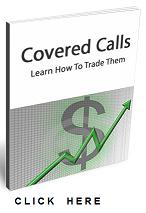Search Options Trading Mastery:
Trading Covered Calls
Trading Covered Calls During a Financial Meltdown
Trading covered calls is considered to be one of the safest option trading strategies, but it does have its risks. If you buy some shares with the intention of selling call options at exercise prices above your share purchase price, there is always the chance that the stock price may drop dramatically, particularly during times of economic uncertainty.
There are some ways to mitigate the effects of financial meltdowns on stocks when trading covered calls. If you originally sold out-of-the-money calls and then the underlying price plummets, you can buy back the now WAY-out-of-the-money calls for next to nothing and then sell the same number of calls at an exercise price close to your share purchase price.
If you sell in-the-money calls at this point, the premium you receive will be greater but it may not be enough to cover the capital loss on the shares, should you be "called" to sell them at expiration date. You could also consider selling deep-in-the-money calls where the delta is close to 1.0 but again, the options' intrinsic value alone at this point, will not cover the capital loss on the shares.
Trading Covered Calls - Falling Stock Price Example
For example, you bought the shares at $20 and immediately wrote $21 OTM call options. Then the share price dropped to $18. If you fear the worst, you can buy back your $21 calls (cheap) and write $10 deep ITM call options at this point.
The intrinsic value in the $10 calls will be $8 ($18-$10) plus some "time value" - so if by expiration date, the stock price has fallen to $12 ... you may be forced (called) to sell the shares for $10, thus incurring a $10 loss. But this is offset by the $8 + 'time value' premium you received on the $10 calls + the profit you received on the $21 sold calls - so that you may even come close to breaking even.
Another Way - Construct a "Collar"
Another way of trading covered calls during a financial meltdown, is to construct an option "collar". This involves the conventional purchase of shares and sale of call options, but with additional protection to the downside in the form of going long (buying) put options. The idea is to buy OTM put options because they are cheaper - and you will often find that their cost is close to the sale price of the call options, leaving only a potential gain on the shares themselves but also giving downside protection. But you don't have to do it straight away. You could buy the shares, wait a few days till the market price rises a little and then purchase your puts (which will now be out-of-the-money) at a much cheaper price than if you did so at share purchase date.
Now imagine if you adopted this "collar" strategy when trading covered calls and in addition, implement the deep-in-the-money sold call option strategy as outlined two paragraphs above. Let's take a look at how it works out now . . .
At expiration date the share price has fallen from $20 to $12 as above. You have a $10 loss on the shares but this is offset by the $8 + time value on the sold $10 calls, plus the profit on the $21 call options. But you also have your $20 put options which are now $8 in-the-money. Let's say you would've just broke even, or made a small loss, on the call options and shares. Trading covered calls with a "collar" means that your put options will turn the otherwise zero profit into an $8 one (minus the cost of the puts).
Pretty good, don't you think?
And a much safer way of trading covered calls during times of economic uncertainty.
If you're in a bull market and the share price just keeps going up, the collar won't produce these results. Your shares will make a one dollar profit, plus you receive the premium received on the $21 calls, less the cost of the protective put options. If you buy the puts on a retracement (in the case of a downtrend) or on an upward move above share purchase price, so that they are out-of-the-money, the premium received from the $21 calls should offset the cost of the puts. You could of course, choose to buy OTM puts at a lower strike price. This will lower your profit should the share price fall.
**************** ****************
Return to Covered Calls Contents Page
Go to Option Trading Homepage















New! Comments
Have your say about what you just read! Leave me a comment in the box below.